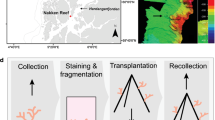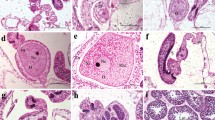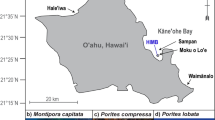Abstract
To understand how environmental conditions and reproductive events affect coral energetic status, seasonal variations in lipid and fatty acid profiles of the common scleractinian coral, Acropora millepora, were studied from pre-spawning in November 2009 until post-spawning in November 2010 at Halfway Island (in the Keppel Island Group, Southern Great Barrier Reef, Australia). Seasonal chlorophyll levels, photosynthetically active radiation (PAR), rainfall and water temperature were major drivers of the overall coral lipid profile, and this was particularly pronounced in correlations with the important, high-energy lipid, triacylglycerol. This likely reflected changing food sources and feeding modes (i.e. phototrophy vs heterotrophy), which corresponds to the opportunistic feeding behaviour of corals. Water temperature was also a major influencer of the coral fatty acid profile. In particular, saturated fatty acids correlated positively with water temperature, while polyunsaturated fatty acids correlated negatively, reflecting cell membrane fluidity regulation, which is necessary for coral to tolerate changing temperatures. Spawning and maternal provisioning also proved to be a major driver of change in the coral lipid profile. The mass spawning events in spring for both 2009 and 2010 caused reductions in the important coral egg constituents: wax ester, triacylglycerol, phosphatidylcholine and fatty acid 10:0. Interestingly, lipid accumulation was significantly lower in the 2010 spawn compared to 2009, possibly due to lower PAR and chlorophyll levels, reflecting reduced photosynthetic activity and phytoplankton availability. Regardless, in 2010, resource provisioning to egg production was greater than in 2009, suggesting increased reproductive effort in the face of environmental stress. This study demonstrates the strong influence of opportunistic heterotrophy and autotrophy and maternal provisioning on the coral lipid profile. Such information is fundamental to understanding the environmental and biochemical processes underlying coral health and predicting how anomalous events and climate-driven changes will affect coral reef assemblages.






Similar content being viewed by others
References
Abdul Wahab MA et al (2014) Phenology of sexual reproduction in the common coral reef sponge, Carteriospongia foliascens. Coral Reefs 33(2):381–394. https://doi.org/10.1007/s00338-013-1119-9
Ahn I-Y et al (2000) Lipid content and composition of the Antartic lamellibranch, Laternula elliptica (King & Broderip) (Anomalodesmata: Laternulidae). In: King George Island during an austral summer. Polar Biol, pp 24–33
Anderson MJ, Willis TJ (2003) Canonical analysis of principal coordinates: a useful method of constrained ordination for ecology. Ecology 84(2):511–525
Anthony K, Fabricius K (2000) Shifting roles of heterotrophy and autotrophy in coral energetics under varying turbidity. J Exp Marine Biol Ecol 252(2): 221–253. http://www.ncbi.nlm.nih.gov/pubmed/10967335
Anthony KR (1999) Coral suspension feeding on fine particulate matter. J Exp Mar Biol Ecol 232(1):85–106. https://doi.org/10.1016/S0022-0981(98)00099-9
Anthony KRN et al (2009) Energetics approach to predicting mortality risk from environmental stress: a case study of coral bleaching. Funct Ecol 23(3):539–550. https://doi.org/10.1111/j.1365-2435.2008.01531.x
Anthony KRN, Connolly SR, Willis BL (2002) Comparative analysis of energy allocation to tissue and skeletal growth in corals. Limnol Oceanogr 47(5):1417–1429. https://doi.org/10.4319/lo.2002.47.5.1417
Arai T et al (1993) Lipid composition of positvely buoyant eggs of reef building corals. Coral Reefs 12:71–75
Baird AH, Guest JR, Willis BL (2009) Systematic and biogeographical patterns in the reproductive biology of scleractinian corals. Annu Rev Ecol Evol Syst 40(1):551–571. https://doi.org/10.1146/annurev.ecolsys.110308.120220
Bay LK et al (2013) Gene expression signatures of energetic acclimatisation in the reef building coral Acropora millepora. PLoS ONE. https://doi.org/10.1371/journal.pone.0061736
Bergé J, Barnathan G (2005) Fatty acids from lipids of marine organisms: molecular biodiversity, roles as biomarkers, biologically active compounds, and economical aspects. Adv Biochem Eng Biotechnol 96:49–125
BOM (2010) Queensland in 2010: the wettest year on record, Australian Government Bureau of Meterology. http://www.bom.gov.au/climate/current/annual/qld/archive/2010.summary.shtml
BOM (2011) Record sea surface temperatures, Australian Government Bureau of Meterology. http://www.bom.gov.au/climate/enso/history/ln-2010-12/Ssterol-records.shtml
Brooke S, Järnegren J (2013) Reproductive periodicity of the scleractinian coral Lophelia pertusa from the Trondheim Fjord, Norway. Mar Biol 160(1):139–153. https://doi.org/10.1007/s00227-012-2071-x
Cipriano RC et al (2015) Differential metabolite levels in response to spawning-induced inappetence in Atlantic salmon Salmo salar. Comp Biochem Physiol Part D Genom Proteom 13:52–59. https://doi.org/10.1016/j.cbd.2015.01.001
Conlan JA et al (2014) Changes in the nutritional composition of captive early-mid stage Panulirus ornatus phyllosoma over ecdysis and larval development. Aquaculture 434:159–170. https://doi.org/10.1016/j.aquaculture.2014.07.030
Conlan JA et al (2017a) Influence of different feeding regimes on the survival, growth, and biochemical composition of Acropora coral recruits. PLoS ONE. https://doi.org/10.1371/journal.pone.0188568
Conlan JA, Rocker MM, Francis DS (2017b) A comparison of two common sample preparation techniques for lipid and fatty acid analysis in three different coral morphotypes reveals quantitative and qualitative differences. PeerJ. https://doi.org/10.7717/peerj.3645
Connelly TL et al (2015) Annual cycle of lipid content and lipid class composition in zooplankton from the Beaufort Sea shelf, Canadian Arctic. Can J Fish Aquat Sci. https://doi.org/10.1139/cjfas-2015-0333
Costa CF, Sassi R, Amaral FD (2005) Annual cycle of symbiotic dinoflagellates from three species of scleractinian corals from coastal reefs of northeastern Brazil. Coral Reefs 24(2):191–193. https://doi.org/10.1007/s00338-004-0446-2
Coutteau P et al (1997) Review on the dietary effects of phospholipids in fish and crustacean larviculture. Aquaculture 155(1–4):149–164. https://doi.org/10.1016/S0044-8486(97)00125-7
Dalsgaard J et al (2003) Fatty acid trophic markers in the pelagic marine environment. Adv Marine Biol, 46, pp. 225–340. http://www.ncbi.nlm.nih.gov/pubmed/14601414
Davidson J et al (2019) High spatio-temporal variability in Acroporidae settlement to inshore reefs of the Great Barrier Reef. PLoS ONE 14(1):e0209771
Dodds LA et al (2009) Lipid biomarkers reveal geographical differences in food supply to the cold-water coral Lophelia pertusa (Scleractinia). Mar Ecol Prog Ser 397:113–124. https://doi.org/10.3354/meps08143
Dridi S, Romdhane MS, Elcafsi M (2007) Seasonal variation in weight and biochemical composition of the Pacific oyster, Crassostrea gigas in relation to the gametogenic cycle and environmental conditions of the Bizert lagoon, Tunisia. Aquaculture 263(1–4):238–248. https://doi.org/10.1016/j.aquaculture.2006.10.028
Fabricius KE (2005) Effects of terrestrial runoff on the ecology of corals and coral reefs: review and synthesis. Mar Pollut Bull 50(2):125–146. https://doi.org/10.1016/j.marpolbul.2004.11.028
Farre B, Cuif JP, Dauphin Y (2010) Occurrence and diversity of lipids in modern coral skeletons. Zoology. Elsevier GmbH 113(4):250–257. https://doi.org/10.1016/j.zool.2009.11.004
Figueiredo J et al (2012) Ontogenetic change in the lipid and fatty acid composition of scleractinian coral larvae. Coral Reefs 31(2):613–619. https://doi.org/10.1007/s00338-012-0874-3
Filimonova V et al (2016) Fatty acid profiling as bioindicator of chemical stress in marine organisms: a review. Ecol Ind 67:657–672. https://doi.org/10.1016/j.ecolind.2016.03.044
Fontagne S, Corraze G, Bergot P (2000) Response of common carp (Cyprinus carpio) larvae to different dietary levels and forms of supply of medium-chain fatty acids. Aquat Living Resour 13:429–437
Grottoli AGG, Rodrigues LJJ, Juarez C (2004) Lipids and stable carbon isotopes in two species of Hawaiian corals, Porites compressa and Montipora verrucosa, following a bleaching event. Mar Biol 145(3):621–631. https://doi.org/10.1007/s00227-004-1337-3
Grottoli AG, Rodrigues LJ, Palardy JE (2006) Heterotrophic plasticity and resilience in bleached corals. Nature 440(7088):1186–1189. https://doi.org/10.1038/nature04565
Harii S et al (2007) Temporal changes in settlement, lipid content and lipid composition of larvae of the spawning hermatypic coral Acropora tenuis. Mar Ecol Prog Ser 346:89–96. https://doi.org/10.3354/meps07114
Harland AD et al (1993) Lipids of some Caribbean and Red Sea corals: total lipid, wax esters, triglycerides and fatty acids. Mar Biol 117(1):113–117. https://doi.org/10.1007/BF00346432
Harrison PL (2011) Sexual reproduction of scleractinian corals. In: Dubinsky Z, Stambler N (eds) Coral reefs: an ecosystem in transition. Springer, Dordrecht. https://doi.org/10.1007/978-94-007-0114-4
Hatcher BG (1990) Coral reef primary productivity. A hierarchy of pattern and process. Trends Ecol Evol 5(5):149–155. https://doi.org/10.1016/0169-5347(90)90221-X
Hauville MR et al (2016) Fatty acid utilization during the early larval stages of Florida pompano (Trachinotus carolinus) and Common snook (Centropomus undecimalis). Aquac Res 47(5):1443–1458. https://doi.org/10.1111/are.12602
Hemond EM, Kaluziak ST, Vollmer SV (2014) The genetics of colony form and function in Caribbean Acropora corals. BMC Genom 15(1):1133. https://doi.org/10.1186/1471-2164-15-1133
Hillestad M et al (2011) Medium-chain and long-chain fatty acids have different postabsorptive fates in Atlantic salmon. J Nutrit 141:1618–1625. https://doi.org/10.3945/jn.111.141820.portal
Hinrichs S, Patten NL, Allcock RJN et al (2013a) Seasonal variations in energy levels and metabolic processes of two dominant Acropora species (A. spicifera and A. digitifera) at Ningaloo Reef. Coral Reefs 32(3):623–635. https://doi.org/10.1007/s00338-013-1027-z
Hinrichs S, Patten NL, Feng M et al (2013b) Which environmental factors predict seasonal variation in the coral health of Acropora digitifera and Acropora spicifera at Ningaloo Reef? PLoS ONE. https://doi.org/10.1371/journal.pone.0060830
Hoegh-Guldberg O et al (2007) Vulnerability of reef-building corals on the Great Barrier Reef to climate change. In: Johnson JE, Marshal PA (eds) Climate change and the great barrier reef a vulnerability assessment. Great Barrier Marine Park Authority and Australian Greenhouse Office, Australia, pp 271–307
Imbs AB (2013) Fatty acids and other lipids of corals: composition, distribution, and biosynthesis. Russ J Mar Biol 39(3):153–168. https://doi.org/10.1134/S1063074013030061
Imbs AB, Latyshev NA (2011) Fatty acid composition as an indicator of possible sources of nutrition for soft corals of the genus Sinularia (Alcyoniidae). J Mar Biol Assoc UK 92(06):1341–1347. https://doi.org/10.1017/S0025315411001226
Izquierdo MS, Biologia D, De Gran P (1996) Essential fatty acid requirements of cultured marine fish larvae’. Aquac Nutr 2:183–191. https://doi.org/10.1111/j.1365-2095.1996.tb00058.x
Jeffs AG et al (2002) Marked depletion of polar lipid and non-essential fatty acids following settlement by post-larvae of the spiny lobster Jasus verreauxi. Comp Biochem Physiol- Mol Integr Physiol 131(2):305–311. https://doi.org/10.1016/S1095-6433(01)00455-X
Jones AM, Berkelmans R, Houston W (2011) Species richness and community structure on a high latitude reef: implications for conservation and management. Diversity 3(3):329–355. https://doi.org/10.3390/d3030329
Kainz M, Fisk A (2009) Integrating lipids and contaminants in aquatic ecology and ecotoxicology. In: Kainz M, Brett MT, Arts MT (eds) Lipids in aquatic ecosystems. Springer, New York, pp 93–114. https://doi.org/10.1007/978-0-387-89366-2
Kamler E (2008) Resource allocation in yolk-feeding fish. Rev Fish Biol Fisheries 18(2):143–200. https://doi.org/10.1007/s11160-007-9070-x
Kindt R, Coe R (2005) Tree diversity analysis. A manual and software for common statistical methods for ecological and biodiversity studies. World Agroforestry Centre (ICRAF), Nairobi, Kenya. http://www.worldagroforestry.org/treesandmarkets/tree_diversity_analysis.asp
Lall SP (2002) The minerals. Fish Nutrit. https://doi.org/10.1016/b978-012319652-1/50006-9
Latyshev NA et al (1991) Fatty acids of reef-building corals. Mar Ecol Prog Ser 76(3):295–301. https://doi.org/10.3354/meps076295
Laurel BJ, Copeman LA, Parrish CC (2012) Role of temperature on lipid/fatty acid composition in Pacific cod (Gadus macrocephalus) eggs and unfed larvae. Mar Biol 159(9):2025–2034. https://doi.org/10.1007/s00227-012-1989-3
Leuzinger S, Anthony KRN, Willis BL (2003) Reproductive energy investment in corals: scaling with module size. Oecologia 136(4):524–531. https://doi.org/10.1007/s00442-003-1305-5
Leuzinger S, Willis BL, Anthony KRN (2012) Energy allocation in a reef coral under varying resource availability. Mar Biol 159(1):177–186. https://doi.org/10.1007/s00227-011-1797-1
Lin C et al (2013) Lipid content and composition of oocytes from five coral species: potential implications for future cryopreservation efforts. PLoS ONE 8(2):e57823. https://doi.org/10.1371/journal.pone.0057823
de Meniburu F (2015) agricolae: statistical procedures for agricultural research. R package version 1.2-3. https://cran.r-project.org/package=agricolae
MoonConnection.com (2018) October 2010 Moon phases. http://www.moonconnection.com/moon-October-2010.phtml. Accessed: 23 March 2018
Ojea J et al (2004) Seasonal variation in weight and biochemical composition of the tissues of Ruditapes decussatus in relation to the gametogenic cycle. Aquaculture 238(1–4):451–468. https://doi.org/10.1016/j.aquaculture.2004.05.022
Oku H et al (2003a) Seasonal changes in the content and composition of lipids in the coral Goniastrea aspera. Coral Reefs 22:83–85. https://doi.org/10.1007/s00338-003-0279-4
Oku H, Yamashiro H, Onaga K (2003b) Lipid biosynthesis from [14C] -glucose in the coral Montipora digitata. Fish Sci 69:625–631
Van Oppen MJH et al (2011) Historical and contemporary factors shape the population genetic structure of the broadcast spawning coral, Acropora millepora, on the Great Barrier Reef. Mol Ecol 20(23):4899–4914. https://doi.org/10.1111/j.1365-294X.2011.05328.x
Palardy J, Grottoli A, Matthews K (2005) Effects of upwelling, depth, morphology and polyp size on feeding in three species of Panamanian corals. Mar Ecol Prog Ser 300:79–89. https://doi.org/10.3354/meps300079
Parma L et al (2015) Fatty acid composition of eggs and its relationships to egg and larval viability from domesticated common sole (Solea solea) breeders. Reprod Domest Anim 50(2):186–194. https://doi.org/10.1111/rda.12466
Parrish CC (2013) Lipids in marine ecosystems. ISRN Oceanogr 2013:1–16. https://doi.org/10.5402/2013/604045
Parrish CC, Bodennec G, Gentien P (1996) Determination of glycoglyerolipids by Chromarod thin-layer chromatography with Iatroscan flame ionization detection. J Chromatogr 741:91–97
Patton JS, Abraham S, Benson AA (1977) Lipogenesis in the intact coral Pocillopora capitata and its isolated zooxanthellae: evidence for a light-driven carbon cycle between symbiont and host. Mar Biol 44(3):235–247. https://doi.org/10.1007/BF00387705
R Development Core Team (2018) R: a language and environment for statistical computing. R Foundation for Statistical Computing. R Foundation for Statistical Computing, Vienna, Austria. http://www.r-project.org
Ribes M et al (2003) Particle removal by coral reef communities: picoplankton is a major source of nitrogen. Mar Ecol Prog Ser 257:13–23
Ribes M, Coma R, Gili JM (1999) Heterogeneous feeding in benthic suspension feeders: the natural diet and grazing rate of the temperate gorgonian Paramuricea clavata (Cnidaria: Octocorallia) over a year cycle. Mar Ecol Prog Ser 183:125–137. https://doi.org/10.3354/meps183125
Richmond RH (1987) Energetic relationships and biogeographical differences among fecundity, growth and reproduction in the reef coral Pocillopora damicornis. Bull Mar Sci 41(2):594–604
Rodrigues LJ, Grottoli AG (2006) Lipids and chlorophyll in bleached and recovering Montipora capitata from Hawaii: : an experimental approach. In: Proceedings of the 10th international coral reef symposium, Okinawa, Japan, 701, pp 696–701
Rossi S et al (2006) Temporal variation in protein, carbohydrate, and lipid concentrations in Paramuricea clavata (Anthozoa, Octocorallia): evidence for summer-autumn feeding constraints. Mar Biol 149(3):643–651. https://doi.org/10.1007/s00227-005-0229-5
RStudio Team (2018) RStudio: integrated development environment for R. Boston, MA. http://www.rstudio.com/
Ryan D et al (2006) Geomorphology and Sediment Transport in Keppel Bay, central Queensland, Australia, Cooperative Research Centre for Coastal Zone. Estuary and Waterway Management, Indooroopilly
Saito H et al (2015) Variation of lipids and fatty acids of the Japanese Freshwater Eel, Anguilla japonica, during spawning migration. J Oleo Sci 616(6):603–616. https://doi.org/10.5650/jos.ess14293
Sargent J et al (1999) Lipid nutrition of marine fish during early development: current status and future directions. Aquaculture 179(1–4):217–229. https://doi.org/10.1016/S0044-8486(99)00191-X
Sargent JR, Tocher DR, Bell JG (2003) The lipids. Fish Nutrit. https://doi.org/10.1016/b978-012319652-1/50005-7
Scott A, Harrison PL, Brooks LO (2013) Reduced salinity decreases the fertilization success and larval survival of two scleractinian coral species. Mar Environ Res Elsevier Ltd 92:10–14. https://doi.org/10.1016/j.marenvres.2013.08.001
Seemann J et al (2013) The use of lipids and fatty acids to measure the trophic plasticity of the coral Stylophora subseriata. Lipids 48(3):275–286. https://doi.org/10.1007/s11745-012-3747-1
Solomon S et al (2007) Intergovernmental Panel on Climate Change, Climate Change 2007: The Physical Science Basis. Cambridge University Press, Cambridge
Thompson A et al (2011) Reef rescue marine monitoring program. In: Report of AIMS Activities–Inshore coral reef monitoring, https://doi.org/10.13140/rg.2.1.1287.1206
Thompson A et al (2017) Annual report for inshore coral reef monitoring 2016-17, p 141
Titlyanov EA et al (2006) Influence of winter and spring/summer algal communities on the growth and physiology of adjacent scleractinian corals. Bot Mar 49(3):200–207. https://doi.org/10.1515/BOT.2006.025
Tocher DR (2003) Metabolism and functions of lipids and fatty acids in teleost fish. Rev Fish Sci 11(2):107–184
Tocher DR et al (2008) The role of phospholipids in nutrition and metabolism of teleost fish. Aquaculture 280(1–4):21–34. https://doi.org/10.1016/j.aquaculture.2008.04.034
Treignier C et al (2008) Effect of light and feeding on the fatty acid and sterol composition of zooxanthellae and host tissue isolated from the scleractinian coral Turbinaria reniformis. Limnol Oceanogr 53(6):2702–2710. https://doi.org/10.4319/lo.2008.53.6.2702
Urzúa Á et al (2011) Seasonal and interannual variations in size, biomass and chemical composition of the eggs of North Sea shrimp, Crangon crangon (Decapoda: Caridea). Mar Biol 159(3):583–599. https://doi.org/10.1007/s00227-011-1837-x
Venables H, Moore CM (2010) Phytoplankton and light limitation in the Southern Ocean: learning from high-nutrient, high-chlorophyll areas. J Geophys Res 115(C2):C02015. https://doi.org/10.1029/2009JC005361
Veron SS (2000) Corals of the world. Australian Institute of Marine Science, Townsville
Viladrich N et al (2016) Variation in lipid and free fatty acid content during spawning in two temperate octocorals with different reproductive strategies: surface versus internal brooder. Coral Reefs. https://doi.org/10.1007/s00338-016-1440-1
Weeks SJ et al (2010) The capricorn eddy: a prominent driver of the ecology and future of the southern Great Barrier Reef. Coral Reefs 29(4):975–985. https://doi.org/10.1007/s00338-010-0644-z
Wickham H (2016) ggplot2: elegant graphics for data analysis. Springer, New York. http://ggplot2.org
Yamashiro H et al (1999) Composition of lipids, fatty acids and sterols in Okinawan corals. Comp Biochem Physiol B Biochem Mol Biol 122(4):397–407. https://doi.org/10.1016/S0305-0491(99)00014-0
Acknowledgements
We would like to thank Mr Scott Gardiner and numerous volunteers for help with sample collections. This project was conducted under GBRMPA Permit G12/35236.1.
Author information
Authors and Affiliations
Corresponding author
Ethics declarations
Conflict of interest
On behalf of all authors, the corresponding author states that there is no conflict of interest.
Additional information
Publisher's Note
Springer Nature remains neutral with regard to jurisdictional claims in published maps and institutional affiliations.
Topic Editor Morgan S. Pratchett
Electronic supplementary material
Below is the link to the electronic supplementary material.
Rights and permissions
About this article
Cite this article
Conlan, J.A., Bay, L.K., Jones, A. et al. Seasonal variation in the lipid profile of Acropora millepora at Halfway Island, Great Barrier Reef. Coral Reefs 39, 1753–1765 (2020). https://doi.org/10.1007/s00338-020-02001-w
Received:
Accepted:
Published:
Issue Date:
DOI: https://doi.org/10.1007/s00338-020-02001-w




